Scientists at Tohoku University have used cryo-electron microscopy to investigate the structure of the secretory pathway Ca2+/Mn2+-ATPase (SPCA) protein, which transports calcium and manganese ions into the Golgi apparatus and is involved in preventing toxic build-up of manganese in the cell cytoplasm. The team was able to determine three different states of the protein and mapped where mutations can cause functional defects, leading to Hailey-Hailey disease, a rare genetic disorder that causes blister patches in the skin. The findings provide important insights into the protein’s mechanism and could help researchers develop treatments not only for Hailey-Hailey disease but also for other neurodegenerative disorders. However, more research is needed to fully understand how the protein works and how calcium and manganese ions are properly balanced inside cells.
Scientists uncover protein’s structure that may aid in treating Hailey-Hailey disease
Hailey-Hailey disease is a rare genetic disorder that causes blister patches to form in the skin folds of the groin, arm pits, and under the breasts. The condition is caused by a mutation in a gene that encodes a protein responsible for transporting calcium and manganese ions from the cell cytoplasm into the Golgi apparatus, an organelle in cells.
Researchers at Tohoku University, Japan, have investigated the structure of this protein, called secretory pathway Ca2+/Mn2+-ATPase (SPCA), and found that it plays a crucial role in maintaining calcium ion balance within cells, which is essential for their proper functioning. SPCA also prevents toxic build-up of manganese in the cell cytoplasm, which can affect the survival of nerve cells.
Using cryo-electron microscopy, the team led by structural biologist Kenji Inaba was able to determine high-resolution 3D structures of human SPCA1a, which revealed how it binds to calcium and manganese ions and transports them into the Golgi lumen. The study also mapped where mutations on the protein can cause functional defects and lead to Hailey-Hailey disease.
The findings, published in the journal Science Advances, could aid in developing treatments not only for Hailey-Hailey disease but also for other neurodegenerative conditions.
“The knowledge about the mechanisms of SPCA1a regulation revealed by our study will be of physiological and medical significance,” says Inaba.
Cryo-electron microscopy provides insights into protein states involved in calcium and manganese transport
Cryo-electron microscopy is a technique that uses very low temperatures to freeze protein samples, immobilizing their molecular motions. This allows researchers to capture a specific state of the protein, as they cannot observe its natural motion. In a recent study, scientists at Tohoku University used the technique to investigate three states of the secretory pathway Ca2+/Mn2+-ATPase (SPCA) protein: bound to calcium and manganese ions, bound to ATP, and in its metal-unbound phosphorylated state. The findings provide important insights into how the protein transports calcium and manganese ions into the Golgi apparatus, as well as how mutations in the protein can lead to Hailey-Hailey disease and other neurodegenerative disorders. However, further research is needed to fully understand the protein’s mechanism.
Don’t miss interesting posts on Famousbio

